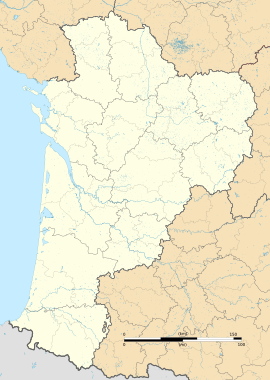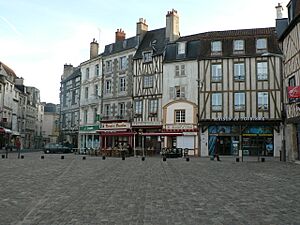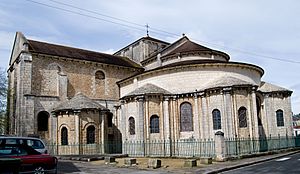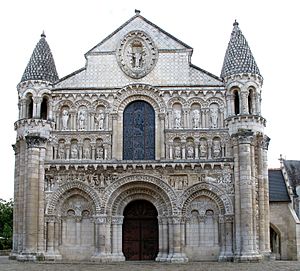Poitiers facts for kids
Quick facts for kids
Poitiers
Poetàe (Poitevin–Saintongeais)
|
||
|---|---|---|
|
Prefecture and commune
|
||
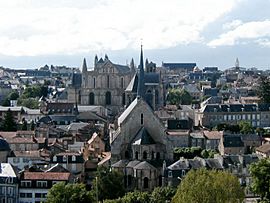
Historic centre of Poitiers with Church of Saint-Radegund, Cathedral of Saint-Pierre and the Palace of Poitiers in the background
|
||
|
||
| Country | France | |
| Region | Nouvelle-Aquitaine | |
| Department | Vienne | |
| Arrondissement | Poitiers | |
| Canton | Poitiers-1, 2, 3, 4 and 5 | |
| Intercommunality | CU Grand Poitiers | |
| Area
1
|
42.11 km2 (16.26 sq mi) | |
| Population
(2021)
|
90,240 | |
| • Density | 2,143.0/km2 (5,550.2/sq mi) | |
| Demonym(s) | Poitevin·e | |
| Time zone | UTC+01:00 (CET) | |
| • Summer (DST) | UTC+02:00 (CEST) | |
| INSEE/Postal code |
86194 /86000
|
|
| Elevation | 65–144 m (213–472 ft) (avg. 75 m or 246 ft) |
|
| Website | poitiers.fr | |
| 1 French Land Register data, which excludes lakes, ponds, glaciers > 1 km2 (0.386 sq mi or 247 acres) and river estuaries. | ||
Poitiers is a historic city in west-central France, located on the Clain river. It's the main city of the Vienne area and was once the capital of Poitou. In 2021, about 90,240 people lived there. Poitiers is often called the "City of a Hundred Bell Towers" because of its many old churches.
It's a big university city, with over 30,000 students. The University of Poitiers started way back in 1431. Famous thinkers like René Descartes and François Rabelais studied here. The city center is very pretty, with lots of old buildings. You can see many Romanesque churches, like the Baptistère Saint-Jean from the 4th century and the Church of Notre-Dame-la-Grande from the 12th century. The Palace of Poitiers was once where powerful counts and dukes lived, including Eleanor of Aquitaine.
Poitiers is famous for two major battles fought nearby. The first was in 732, sometimes called the Battle of Tours. In this battle, the Franks, led by Charles Martel, defeated an army from the Umayyad Caliphate. The second, the Battle of Poitiers in 1356, was a key moment in the Hundred Years' War. The English army won, and the French King John II was captured.
Today, Poitiers is also known for Futuroscope, a huge theme park and technology center. It's located between Paris and Bordeaux. Futuroscope attracts about two million visitors each year. It's one of the most popular amusement parks in France.
Contents
Geography
Where is Poitiers?
Poitiers is in a special spot called the Seuil du Poitou. This is a low area between two mountain ranges, the Armorican Massif and the Massif Central. This location connects the Aquitaine Basin in the south to the Paris Basin in the north. It's an important crossroads in France and Western Europe.
How is the city built?
The old part of Poitiers sits on a large hill between the Boivre and Clain river valleys. The town spreads up the slopes and across the top of this plateau. It rises about 130 feet (40 meters) above the rivers. This high position made it a very strong place to defend, especially during the Middle Ages.
People and Population
People who live in Poitiers are called Poitevins (for men) or Poitevines (for women). This name can also be used for anyone from the larger Poitou region.
| Historical population | ||||||||||||||||||||||||||||||||||||||||||||||||||||||||||||||||||||||||||||||||||||||||||||||||||||||||||||||||||||||
|---|---|---|---|---|---|---|---|---|---|---|---|---|---|---|---|---|---|---|---|---|---|---|---|---|---|---|---|---|---|---|---|---|---|---|---|---|---|---|---|---|---|---|---|---|---|---|---|---|---|---|---|---|---|---|---|---|---|---|---|---|---|---|---|---|---|---|---|---|---|---|---|---|---|---|---|---|---|---|---|---|---|---|---|---|---|---|---|---|---|---|---|---|---|---|---|---|---|---|---|---|---|---|---|---|---|---|---|---|---|---|---|---|---|---|---|---|---|---|
|
|
|||||||||||||||||||||||||||||||||||||||||||||||||||||||||||||||||||||||||||||||||||||||||||||||||||||||||||||||||||||
| Source: EHESS and INSEE (1968-2017) | ||||||||||||||||||||||||||||||||||||||||||||||||||||||||||||||||||||||||||||||||||||||||||||||||||||||||||||||||||||||
Climate
Poitiers has a mild climate. This means the temperatures aren't too extreme, and it rains enough throughout the year. Summers can be a bit drier. This type of climate is known as an "Oceanic climate."
| Climate data for Poitiers (PIS), elevation: 123 m (404 ft), 1981–2010 normals, extremes 1921–present | |||||||||||||
|---|---|---|---|---|---|---|---|---|---|---|---|---|---|
| Month | Jan | Feb | Mar | Apr | May | Jun | Jul | Aug | Sep | Oct | Nov | Dec | Year |
| Record high °C (°F) | 17.7 (63.9) |
23.4 (74.1) |
25.1 (77.2) |
29.3 (84.7) |
33.6 (92.5) |
39.0 (102.2) |
40.8 (105.4) |
39.6 (103.3) |
35.4 (95.7) |
30.9 (87.6) |
22.9 (73.2) |
19.0 (66.2) |
40.8 (105.4) |
| Mean daily maximum °C (°F) | 7.8 (46.0) |
9.3 (48.7) |
12.9 (55.2) |
15.5 (59.9) |
19.5 (67.1) |
23.2 (73.8) |
25.8 (78.4) |
25.7 (78.3) |
22.2 (72.0) |
17.4 (63.3) |
11.5 (52.7) |
8.2 (46.8) |
16.6 (61.9) |
| Daily mean °C (°F) | 4.7 (40.5) |
5.3 (41.5) |
8.0 (46.4) |
10.2 (50.4) |
14.0 (57.2) |
17.3 (63.1) |
19.6 (67.3) |
19.4 (66.9) |
16.3 (61.3) |
12.8 (55.0) |
7.8 (46.0) |
5.1 (41.2) |
11.7 (53.1) |
| Mean daily minimum °C (°F) | 1.5 (34.7) |
1.3 (34.3) |
3.1 (37.6) |
4.9 (40.8) |
8.6 (47.5) |
11.5 (52.7) |
13.4 (56.1) |
13.1 (55.6) |
10.4 (50.7) |
8.2 (46.8) |
4.0 (39.2) |
2.0 (35.6) |
6.9 (44.4) |
| Record low °C (°F) | −17.9 (−0.2) |
−17.3 (0.9) |
−13.1 (8.4) |
−5.6 (21.9) |
−2.7 (27.1) |
0.8 (33.4) |
1.5 (34.7) |
0.8 (33.4) |
0.8 (33.4) |
−6.5 (20.3) |
−10.0 (14.0) |
−16.5 (2.3) |
−17.9 (−0.2) |
| Average precipitation mm (inches) | 61.8 (2.43) |
46.2 (1.82) |
47.4 (1.87) |
56.1 (2.21) |
62.6 (2.46) |
51.5 (2.03) |
50.5 (1.99) |
41.2 (1.62) |
51.1 (2.01) |
75.6 (2.98) |
72.8 (2.87) |
68.8 (2.71) |
685.6 (26.99) |
| Average precipitation days (≥ 1.0 mm) | 10.5 | 8.9 | 8.9 | 10.1 | 10.7 | 7.6 | 7.1 | 6.2 | 6.9 | 10.5 | 11.2 | 10.7 | 109.3 |
| Average snowy days | 2.6 | 2.8 | 1.9 | 0.5 | 0.0 | 0.0 | 0.0 | 0.0 | 0.0 | 0.0 | 0.9 | 2.2 | 10.9 |
| Average relative humidity (%) | 86 | 82 | 77 | 74 | 75 | 73 | 70 | 72 | 77 | 83 | 87 | 88 | 79 |
| Mean monthly sunshine hours | 69.7 | 96.1 | 153.8 | 174.6 | 206.5 | 232.9 | 242.7 | 241.8 | 194.2 | 128.8 | 82.6 | 65.2 | 1,888.8 |
| Source 1: Meteo France | |||||||||||||
| Source 2: Infoclimat.fr (relative humidity 1961–1990) | |||||||||||||
History of Poitiers
Ancient Times
Poitiers was first built by a Celtic tribe called the Pictones. They called their settlement Lemonum. The name Lemonum might have come from the Celtic word for "elm tree." When the Romans took over, they renamed it Pictavium, or later "Pictavis," after the Pictones tribe.
Many Roman ruins have been found in Poitiers. Until 1857, there was a huge Roman amphitheatre here, even bigger than the one in Nîmes. Remains of Roman baths from the 1st century were also found.
In 1879, a burial site with tombs of early Christian martyrs was discovered. Not far from these tombs is a giant stone monument called a dolmen, known as the Pierre Levée. It's about 22 feet (6.7 meters) long and 7 feet (2.1 meters) high.
The Romans also built at least three aqueducts to bring water to the city. All these Roman buildings show that Poitiers was a very important city, possibly even the capital of the Roman area called Gallia Aquitania in the 2nd century.
When Christianity became popular in the Roman Empire, Hilary of Poitiers became the first bishop of Poitiers around 350 AD. He helped spread Christianity in the town. The very first parts of the Baptistère Saint-Jean church were built around this time.
In the 4th century, a strong wall, 6 meters wide and 10 meters high, was built around the town. It was about 2.5 kilometers long. Around this time, the town started to be called Poitiers.
About 50 years later, Poitiers was taken over by the Visigoths, who were a Germanic tribe. It became one of their kings' main homes. But in 507, the Frankish king Clovis I defeated the Visigoth King Alaric II near Poitiers. After this, Poitiers became part of the Frankish kingdom.
The Middle Ages
During the Early Middle Ages, Poitiers was important because of its strong defenses and its location, far from the main Frankish power centers. It had been the seat of a bishopric since the 4th century. The Counts of Poitiers became very powerful, ruling a large area that included both Nouvelle-Aquitaine and Poitou.
The city was sometimes called Poictiers, a name remembered in some Royal Navy warships.
A very important battle, the Battle of Tours, happened near Poitiers on October 10, 732. In this battle, the Christian army of Western Europe, led by Charles Martel, decisively defeated a Muslim army. Many historians believe this battle changed the course of world history.
Eleanor of Aquitaine, a powerful queen of France and England, often lived in Poitiers. She made the city more beautiful and stronger. In 1152, she married the future King Henry II of England in Poitiers Cathedral.
During the Hundred Years' War, another famous battle, the Battle of Poitiers, took place near the city on September 19, 1356. The English won this battle and captured the French king, John II. Later in the war, in 1418, the royal parliament of France moved from Paris to Poitiers. It stayed there until 1436. In 1429, Joan of Arc was formally questioned in Poitiers.
The University of Poitiers was founded in 1431. During and after the Reformation, many people in Poitiers became followers of John Calvin. The city saw some violence during the French Wars of Religion.
In 1569, Poitiers was defended by Gui de Daillon against Gaspard II de Coligny. Coligny tried to attack the city for seven weeks but failed and had to leave.
17th and 18th Centuries
Poitiers was quieter during the Renaissance. Not many big changes happened to the city's layout. Some new bridges were built, and a few fancy private mansions, called hôtels particuliers, appeared. Famous poets Joachim du Bellay and Pierre Ronsard met at the University of Poitiers before moving to Paris.
In the 17th century, many people from Poitiers and the Poitou region moved to French settlements in the New World. Because of this, many Acadians and Cajuns in North America today can trace their family roots back to this area.
During the 18th century, Poitiers mainly served as an administrative center for the region. It was home to royal courts, monasteries, and the main office for the Généralité du Poitou.
The Vicomte de Blossac, who was in charge of Poitou from 1750 to 1784, created a beautiful French garden in Poitiers. He also had Eleanor of Aquitaine's old city wall taken down. Modern boulevards were built in its place.
19th Century
In the 19th century, many army bases were built in Poitiers. This was because of its central and strategic location in France. Poitiers became a "garrison town," meaning it had a large military presence.
The Poitiers train station was built in the 1850s. This connected Poitiers to the rest of France by rail.
20th Century and Today
Poitiers was bombed during World War II. The area around the railway station was hit hard on June 13, 1944.
From the late 1950s to the late 1960s, the U.S. Army and U.S. Air Force had military bases in France. Poitiers was a major logistics and communications center for the U.S. Army. Hundreds of students from Poitiers American High School, a school for military families, went on to successful careers.
In the 1970s, Poitiers saw new industries move in, like Michelin and Compagnie des compteurs Schlumberger factories. The Futuroscope theme-park and research park project was built in 1986–1987. This project, started by René Monory, made Poitiers a popular touristic spot and a modern university center. It also helped the city enter the age of information technology.
Landmarks and Attractions
- Baptistère Saint-Jean (4th century): This is the oldest church in France.
- Palace of Poitiers: Once the home of the dukes of Aquitaine.
- Church of Notre-Dame la Grande: The oldest Romanesque church in Europe.
- Poitiers Cathedral (Cathédrale Saint-Pierre): Built in the 12th century.
- Musée Sainte-Croix: The largest museum in Poitiers.
- Church of St. Radegonde (6th century).
- Church of Saint-Hilaire le Grand (11th century).
- Hypogée des Dunes: An underground chapel.
- Jardin des Plantes de Poitiers: A park and botanical garden.
- Church of Saint-Jean de Montierneuf.
- Théâtre Municipal de Poitiers: The city's old municipal theater.
- Parc du Futuroscope: A theme park about visual communication technology, located about 10 miles (16 km) north of Poitiers.
- Le Confort Moderne: A cultural venue.
Sports
The Stade Poitevin, founded in 1900, is a big sports club. It has several top teams in different sports. These include a volleyball team that plays in the French Pro A league, a basketball team, an amateur football team, and a professional rugby team.
The PB86 basketball team plays in the French Pro A league. In the 2009–10 season, three American players were on the team. They played in the French championship playoffs that season.
Brian Joubert, a famous figure skating champion, trains at Poitiers' ice rink and lives in the city.
Tourism
Old churches, especially Romanesque ones, are the main attractions in Poitiers itself. The city center is very charming, with well-preserved old buildings and a pedestrian area. There are many shops, cafes, and restaurants.
Since 1987, Poitiers' tourism has grown because of the Futuroscope theme park. It's located in nearby Chasseneuil-du-Poitou. Tourists visiting Futuroscope often come to Poitiers as well. The city also gets more European tourists, especially from the United Kingdom. The high-speed TGV train link to Paris has also helped tourism.
Transport
Poitiers' railway station is on the TGV Atlantique high-speed train line. This line connects Paris and Bordeaux. Trains also run to Angoulême, Limoges, and La Rochelle. The direct TGV train makes the trip from Poitiers to Paris' Gare Montparnasse in about 1 hour and 40 minutes.
Poitiers–Biard Airport is about 2.4 kilometers (1.5 miles) west of Poitiers. It has flights to places like Lyon—Saint Exupéry, London Stansted, Edinburgh, and Shannon, Ireland.
Public transportation within Poitiers is run by a company called Vitalis. Regional buses are provided by companies like "Ligne en Vienne." Regional trains are run by TER Nouvelle-Aquitaine.
From 2009 to 2012, Poitiers' city center changed a lot. It became less accessible to cars. This project, called "Projet Coeur d'Agglo," aimed to change how people travel in the city center. On September 29, 2010, 12 streets were closed to cars and became pedestrian-only zones.
A new fast bus system is planned for around 2017.
Education
Poitiers has a very long history as a university city, going back to the Middle Ages. The University of Poitiers was founded in 1431. Many famous thinkers and scientists have studied there, including François Rabelais and René Descartes.
Today, Poitiers has more students per person than almost any other large city in France. There are over 27,000 university students in Poitiers. Nearly 4,000 of them are from other countries, representing 117 different nations. The University offers studies in many areas, from science to geography, history, languages, economics, and law.
The law degree program at the University of Poitiers is considered one of the best in France.
Besides the University, Poitiers also has two engineering schools and two business schools:
- the École nationale supérieure de mécanique et d'aérotechnique (ENSMA)
- the École nationale supérieure d'ingénieurs de Poitiers (ENSIP)
- the France Business School (FBS)
- the Institut d'Administration des Entreprises de Poitiers (IAE).
Since 2001, Poitiers has also hosted a special program from the Paris Institute of Political Studies, also known as Sciences Po. This program focuses on South America, Spain, and Portugal.
International Friends
Poitiers is twinned with these cities around the world:
Famous People from Poitiers
Here are some interesting people who were born or lived in Poitiers:
- Oklou (born 1993): A musician, singer, and producer.
- Hilary of Poitiers (c. 300–367): An early bishop of Poitiers.
- Saint Radegonde (c. 520–587): A Thuringian princess and queen of France who founded an abbey in Poitiers.
- Charles Martel: A French general who won the Battle of Tours in 732.
- Eleanor of Aquitaine: A powerful queen of France and England, who lived in Poitiers.
- François Rabelais: A famous Renaissance writer.
- Pope Clement V: A former Pope.
- St. Venantius Fortunatus: A 6th-century Latin poet and bishop.
- René Descartes: A famous philosopher who studied law at the University of Poitiers.
- Brian Joubert (born 1984): A champion ice skater.
- Michel Foucault (1926–1984): A well-known philosopher.
- Camille Guérin (born 1872): Helped discover a vaccine for tuberculosis.
- Jean-Pierre Raffarin (born 1948): A politician and former Prime Minister of France.
- Joël Robuchon (born 1945): A famous French chef.
- Louis Vierne (1870–1937): An organist and composer.
See also
 In Spanish: Poitiers para niños
In Spanish: Poitiers para niños




